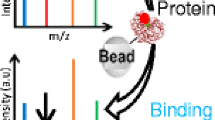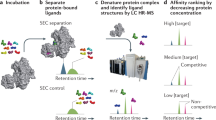Abstract
Drug discovery in the chemogenomic space has seen some tremendous changes over the last decade. Compared to previous times, not only the number of available chemical compounds for screening, but also the number of molecular targets used for screening has increased significantly. This has triggered the need for very fast, efficient, and effective novel readout technologies for compound testing. Novartis has developed two novel high-throughput screening (HTS) technologies for that purpose — NanoScreen and SpeedScreen. NanoScreen is a highly miniaturized and fully automated HTS/uHTS test system with confocal single-molecule as well as non-confocal detection capabilities and is used for functional screening in the range of 1–5 µl per sample. The integration of the single-molecule readout technologies into the system enables highly sophisticated biochemical test systems with multi-parameter readout for very high data quality. SpeedScreen is a highly miniaturized and automated screening system for high-throughput affinity-selection of compounds. In practice, pools of compounds are incubated with the target protein and the unbound chemical compounds are removed from the target-compound complex via very fast, multiparallel size-exclusion-chromatography. The holoenzyme is disintegrated and analyzed via microbore reversed-phase high performance liquid chromatography (microbore RP-HPLC). Both systems have been developed and implemented with great success at the Novartis Lead Discovery Center (LDC) in Basel. These technologies have enabled us to access targets that would otherwise not have been possible, e.g., very expensive targets, “orphan” drug targets, or targets that are “non-tractable” by conventional screening technologies. Taken together, these novel screening technologies enable novel approaches for chemogenomic research that would have not been possible in the past.
Access this chapter
Tax calculation will be finalised at checkout
Purchases are for personal use only
Preview
Unable to display preview. Download preview PDF.
Similar content being viewed by others
References
Brown N, Zehender H, Azzaoui K, Schuffenhauer A, Mayr LM, Jacoby E (2006) A chemoinformatics analysis of hitlists obtained from high-throughput affinity-selection screening. J Biomol Screen 10 (in press)
Hershko A, Ciechanover A (1998) The ubiquitin system. Annu Rev Biochem 67:425–479
Muckenschnabel I, Falchetto R, Mayr LM, Filipuzzi I (2004) SpeedScreen: label-free liquid chromatography-mass spectrometry-based HTS for the discovery of orphan protein ligands. Anal Biochem 324:241–249
Zehender H, Le Goff F, Lehmann N, Filipuzzi I, Mayr LM (2004) SpeedScreen: the ‘missing link’ between genomics and lead discovery. J Biomol Screen 9:498–505
Zhang JH, Chung TD, Oldenburg KR (1999) A simple statistical parameter for use in evaluation and validation of high throughput screening assays. J Biomol Screen 4:67–73
Author information
Authors and Affiliations
Editor information
Editors and Affiliations
Rights and permissions
Copyright information
© 2006 Springer-Verlag Berlin Heidelberg
About this paper
Cite this paper
Mayr, L.M. (2006). Tackling the Chemogenomic Space by Novel Screening Technologies. In: Jaroch, S., Weinmann, H. (eds) Chemical Genomics. Ernst Schering Research Foundation Workshop, vol 58. Springer, Berlin, Heidelberg. https://doi.org/10.1007/978-3-540-37635-4_8
Download citation
DOI: https://doi.org/10.1007/978-3-540-37635-4_8
Publisher Name: Springer, Berlin, Heidelberg
Print ISBN: 978-3-540-27865-8
Online ISBN: 978-3-540-37635-4
eBook Packages: Chemistry and Materials ScienceChemistry and Material Science (R0)




